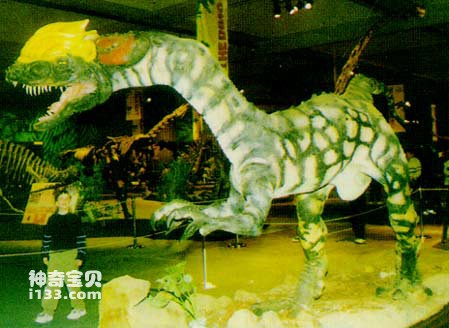In 1942, a larger theropod dinosaur was discovered in the early Jurassic strata of Arizona, USA. Because it had a pair of thin V-shaped bony crests on the top of its head, scientists named it Dicrosaurus. .

Dicrosaurus
Dicrosaurus has a stout body, a tall skull, well-developed jaws, a large mouth, and a mouth full of teeth like sharp knives. There are small serrations on the front and rear edges of the teeth. These features show that it can tear apart anything it captures. It catches prey and then swallows chunks of meat into its belly. In addition, there are holes in the skull of Dicrosaurus behind the eyes. These holes are used to better attach the muscles that affect the jaw bones, so the bite of Dicrosaurus must be very powerful. Scientists speculate that Diplosaurus may have been the most ferocious and ferocious predator in the early Jurassic ecosystem.

Diplosaurus buried with paleopod dinosaurs
The hind limbs of Dicrosaurus were thick and powerful, and the feet had sharp claws that could be used to capture and tear apart prey. During that period of time about 200 million years ago, Dicrosaurus often appeared in the highlands between rivers and lakes or in the jungles, chasing various vegetarian animals. They may also like to live alone, and sometimes they may hide in places where they are not easily discovered, waiting for opportunities to sneak up on prey. They may even feed on the carcasses and carrion of animals that died for various reasons like modern hyenas.
my country has also discovered the fossils of Dicrosaurus in Jinning County, Yunnan Province.
In August 1987, the dinosaur excavation team of the Kunming Municipal Museum of Yunnan Province unearthed a Yunnanosaurus fossil belonging to the paleopod in Xiyang Township, Jinning County. The sudden news attracted people from all over the world to come and watch. The people here are all Yi compatriots, and they have never heard of dinosaurs. But when they looked at the fossils, some thought the bone-shaped stones looked familiar. Some people told the excavation team that they had seen such stones on the hillside of Muganlang Village in Xiyang Township.
The excavation team followed the messenger to Muganlang Village, where indeed a string of dinosaur vertebrae was exposed in a small gully. They decided to excavate here. A few days later, a shocking scene occurred. It turns out there are two dinosaurs here! Moreover, there are two complete dinosaur skeletons twisted together. One of them is a paleopod dinosaur, and the other is a carnivorous dinosaurus. The latter's big mouth just bites on the tail vertebrae of the former. Based on the burial conditions of the fossils, scientists speculate that there may be two causes of death for these two dinosaurs: one is that they were both injured in a life-and-death struggle and both died; another possibility is that the paleopod dinosaurs have been dead for many days. The meat on the corpse had gone rancid, and the hungry theropods just tried to fill their stomachs, but unexpectedly they died of poisoning from eating the rotten paleopod dinosaur meat. Judging from the calm postures of the two, the latter possibility is even greater.
Diplosaurus sinensis was the largest carnivorous dinosaur in the early Jurassic. It was nearly 4 meters long and had a sharp and long mouth. There is a cleft in the front of its upper jaw that allows the premaxilla to move. Scientists speculate that its favorite food is probably the internal organs of other animals, because its sharp beak can be inserted into the abdominal cavity of animal corpses, and the two thin plate-like coronal ridges on the top of its head can be lifted when the head is inserted into the abdominal cavity of the corpse. To support the cavity wall.
Dicrosaurus is also a member of the Tethys Sea fauna, so the species found all over the world are similar. Their fossils have also been found in modern Antarctica, indicating that the now icy Antarctica was a warm dinosaur paradise at that time.
animal tags:
We created this article in conjunction with AI technology, then made sure it was fact-checked and edited by a Animals Top editor.